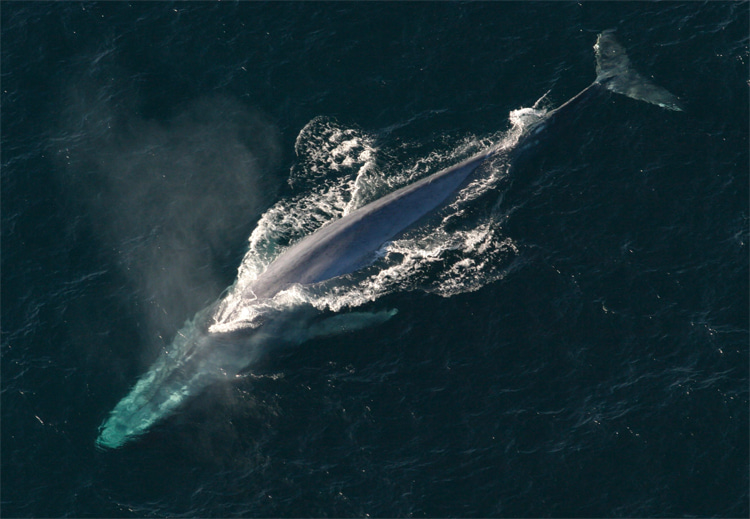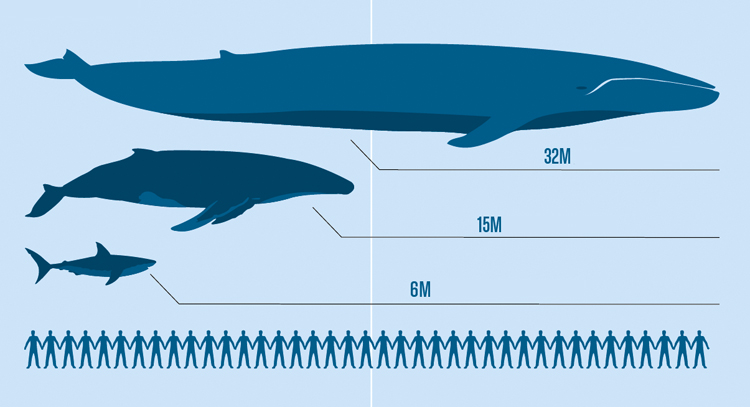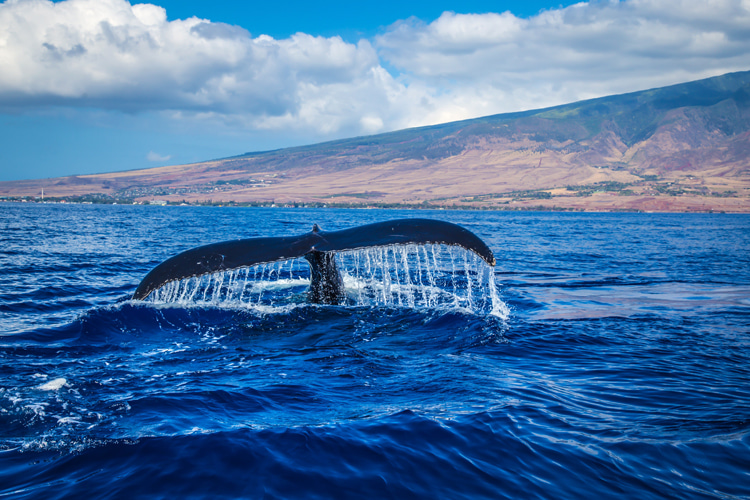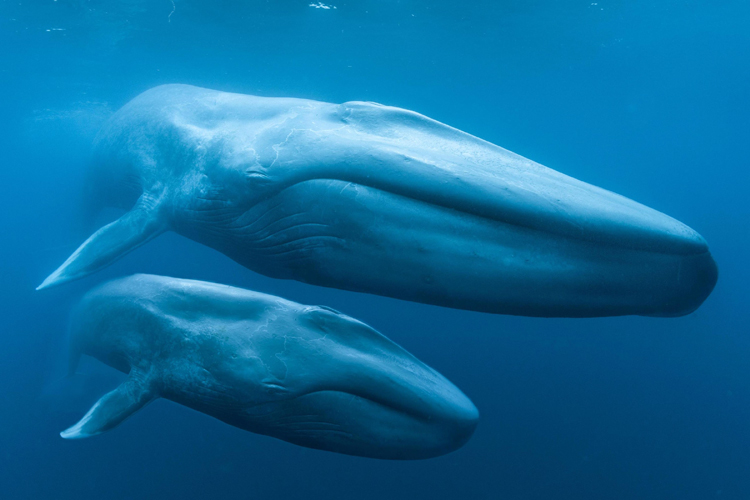The ocean is home to one of the most astonishing creatures in the animal kingdom - the blue whale.
With its sheer size and captivating underwater ballet, this marine titan elicits awe and wonder, revealing Mother Nature's limitless capacity to surprise us.
Witnessing the world's largest animal swimming and diving is of the most remarkable and unforgettable experiences you will ever have.
The immense size of blue whales is a result of evolutionary adaptation in a phenomenon known as gigantism.
There are several factors that have contributed to this, including the abundance of food supply and the existence of nutrient-rich water in deep ocean waters.
So, which secrets and extraordinary figures does this baleen whale hide?
What do scientists, researchers, and environmentalists know about the creature that is as big as a ten-story building?
Let's take a closer look at the giant marine mammal that can be found in all the world's major oceans except the Arctic.
Anatomy and Physical Characteristics
- Blue whales can reach a whopping length of up to 100 feet (30 meters), which is as long as three school buses parked end-to-end.
- The heaviest recorded blue whale weighed an estimated 199 tons (180 metric tons), which is about the same weight as 33 elephants.
- The heart of a blue whale is so massive it's roughly the size of a small car and can weigh nearly 1,300 pounds (590 kilograms).
- Their arteries are so wide that a small child could swim through them.
- When a blue whale's mouth is fully expanded, its capacity is big enough to hold up to 90 metric tons of water and food, which is approximately the weight of 130 adult humans.
- Instead of teeth, blue whales have between 300 to 400 baleen plates in their mouths that act like a sieve, filtering out water and leaving only food behind.
- Their tongues can weigh as much as an elephant, about 5,400 pounds (2,450 kilograms).
- A blue whale's skin is typically blue-gray, but it can appear slightly yellow due to a layer of microorganisms that live on its surface, earning them the occasional nickname of "sulphur-bottom."
- The fluke, or tail, of a blue whale can be up to 25 feet (7.6 meters) wide, roughly the same width as a small aircraft's wingspan.

Lifestyle and Habits
- Blue whales are primarily solitary creatures, often living and traveling alone or in small groups.
- They migrate thousands of miles between feeding and breeding grounds annually.
- Blue whales can live for at least 70 to 90 years, and the oldest known blue whale lived to be 110 years old.
- Blue whale calves drink approximately 100 gallons (379 liters) of their mother's fatty milk every day, gaining about 200 pounds (91 kilograms) daily during the first year of life.
- They hold the distinction of being some of the planet's most vociferous creatures, generating an array of sounds, including pulses, grumbles, and wails. Under optimal conditions, it's believed that their calls can traverse a staggering distance of up to 1,000 miles (1,600 kilometers), allowing them to communicate across vast oceanic expanses.
- Blue whales can dive for up to 60 minutes and reach depths of 1,640 feet (500 meters), though they usually dive a few hundred feet for about ten minutes when feeding.
Diet
- Blue whales feed almost exclusively on krill, consuming up to 4 tons (3.6 metric tons) or about 1.5 million calories worth of these tiny shrimp-like creatures each day during the feeding season.
- They use a technique called lunge feeding, where they accelerate toward a swarm of krill, then open their mouths to take in a large volume of water and krill.
- Despite their enormous size and energy needs, blue whales fast for up to half the year during migration and breeding, living off their fat reserves.
Population and Conservation
- Blue whales are listed as an endangered species, primarily due to whaling activities in the 20th century, which drastically reduced their numbers.
- From an estimated global population of 10,000 to 25,000, blue whale numbers are slowly rebounding since the International Whaling Commission (IWC) implemented a moratorium on commercial whaling in 1966.
- Today, their biggest threats include ship strikes, entanglement in fishing gear, and the effects of climate change on their food supply.

Scientific Studies and Discoveries
- The blue whale genome was fully sequenced in 2018, which has provided invaluable insights into the evolution, physiology, and conservation of this marine behemoth.
- Blue whales have a gestation period of 10 to 12 months, one of the longest in the animal kingdom.
- Despite their size, blue whales can reach speeds of up to 31 miles per hour (50 kilometers per hour), but they usually cruise at about 12 miles per hour (20 kilometers per hour).
- Blue whale calves are the largest babies on Earth, easily surpassing the size of the largest land mammals. They are about 23 feet (7 meters) long at birth and can weigh up to 3 tons (2.7 metric tons).
- Each population of blue whales has its unique song. The low-frequency pulses of these songs can be heard by other whales over hundreds of miles.
- While it's a topic of ongoing research, some scientists believe blue whales use echolocation - a system of producing sounds and then listening to the echoes of these sounds to determine the location of objects - much like dolphins and bats.
Communication and Behavior
- The low-frequency sounds that blue whales make are in the infra-sound range, which means they're often below the threshold of human hearing.
- Different groups of blue whales in different regions have been found to communicate with distinctive dialects.
- They've been observed to swim in perfect synchrony when traveling in groups, especially mother-calf pairs.
- The story of a unique blue whale dubbed the "52-hertz whale" because of its unusually high-pitched song has captivated the public. This whale appears to be the only one of its kind, and its story has been featured in several films and songs, symbolizing loneliness and the desire for connection.
Extraordinary Physiology
- The lungs of a blue whale are so large that they can hold up to 5,000 liters of air, which is around 1,320 gallons.
- Blue whales, like all cetaceans, are warm-blooded and maintain a body temperature similar to humans.
- They have two blowholes side by side, unlike toothed whales, which only have one. When exhaling, a blue whale's blow can reach up to 30 feet (9 meters) in the air, creating a distinctive tall, columnar spout.
- The brain of a blue whale can weigh up to 15 pounds (6.8 kilograms), one of the largest in the animal kingdom, yet relative to body size, it's not exceptionally big.

Environmental Impact and Relationship with Humans
- Through their feasting on krill, blue whales help to control and maintain the health of marine ecosystems.
- Their fecal plumes are rich in iron and nitrogen, key nutrients that stimulate the growth of phytoplankton, which forms the base of the marine food chain and plays a crucial role in removing carbon dioxide from the atmosphere.
- The well-being of blue whales is often seen as an indicator of the overall health of our oceans.
- Blue whales have significant cultural importance in many societies, with their image used in literature, art, and folklore.
- They are a popular species for whale watchers, with their incredible size and graceful movements creating a truly unforgettable spectacle.
Mysteries and Ongoing Research
- The mating habits of blue whales remain largely a mystery to scientists due to the difficulty of observing these events in the wild.
- Despite extensive research, the calving grounds of most blue whale populations remain unknown.
- Recent studies have found that blue whale songs have been gradually deepening in frequency over the past few decades. The reason behind this change is still not understood.
- The genetic diversity among blue whales is surprisingly high considering their small population size, indicating a complex evolutionary history.
- It was only recently discovered that blue whales sleep in a vertical position, essentially standing on their tails, with their heads bobbing above the surface.
Blue Whale Encounters and Popular Culture
- There have been rare instances of blue whales interacting with humans in the wild, such as the diver who was pushed to safety by a blue whale to prevent a potential collision with a boat.
- There have been a few sightings of an extremely rare albino blue whale named "Galaxy." He is considered the only known all-white blue whale in existence.
- A 2015 live television program from PBS and the BBC called "Big Blue Live" showcased a gathering of marine wildlife, including blue whales, in Monterey Bay, California, reaching millions of viewers worldwide.
- Blue whales have been featured in numerous works of fiction, including films, books, and video games. For example, a blue whale and a bowl of petunias were spontaneously called into existence in Douglas Adams' "The Hitchhiker's Guide to the Galaxy," providing a moment of surreal humor. "Blue Whales: Return of the Giants 3D" is also worth watching.
- The songs of blue whales have been recorded and incorporated into music and sound therapy, offering listeners a unique experience that captures the mystery and grandeur of the marine world.
- An immersive experience called "Ocean Odyssey" in New York's Times Square uses high-resolution video projections to give participants a close-up encounter with a blue whale, among other marine species, in an effort to inspire conservation.
